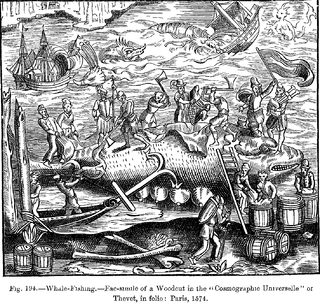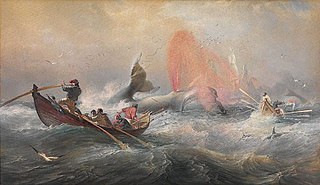
The gray whale, also known as the grey whale, gray back whale, Pacific gray whale, Korean gray whale, or California gray whale, is a baleen whale that migrates between feeding and breeding grounds yearly. It reaches a length of 14.9 meters (49 ft), a weight of up to 41 tonnes (90,000 lb) and lives between 55 and 70 years, although one female was estimated to be 75–80 years of age. The common name of the whale comes from the gray patches and white mottling on its dark skin. Gray whales were once called devil fish because of their fighting behavior when hunted. The gray whale is the sole living species in the genus Eschrichtius. It is the sole living genus in the family Eschrichtiidae, however some recent studies classify it as a member of the family Balaenopteridae. This mammal is descended from filter-feeding whales that appeared during the Neogene.

Whaling is the hunting of whales for their usable products such as meat and blubber, which can be turned into a type of oil that was important in the Industrial Revolution. Whaling was practiced as an organized industry as early as 875 AD. By the 16th century, it had become the principal industry in the Basque coastal regions of Spain and France. The whaling industry spread throughout the world and became very profitable in terms of trade and resources. Some regions of the world's oceans, along the animals' migration routes, had a particularly dense whale population and became targets for large concentrations of whaling ships, and the industry continued to grow well into the 20th century. The depletion of some whale species to near extinction led to the banning of whaling in many countries by 1969 and to an international cessation of whaling as an industry in the late 1980s.

Ulsan, officially the Ulsan Metropolitan City, is South Korea's seventh-largest metropolitan city and the eighth-largest city overall, with a population of over 1.1 million inhabitants. It is located in the south-east of the country, neighboring Busan to the south and facing Gyeongju to the north.

This article discusses the history of whaling from prehistoric times up to the commencement of the International Whaling Commission (IWC) moratorium on commercial whaling in 1986. Whaling has been an important subsistence and economic activity in multiple regions throughout human history. Commercial whaling dramatically reduced in importance during the 19th century due to the development of alternatives to whale oil for lighting, and the collapse in whale populations. Nevertheless, some nations continue to hunt whales even today.

Charles W. Morgan is an American whaling ship built in 1841 that was active during the 19th and early 20th centuries. Ships of this type were used to harvest the blubber of whales for whale oil which was commonly used in lamps. Charles W. Morgan has served as a museum ship since the 1940s and is now an exhibit at the Mystic Seaport museum in Mystic, Connecticut. She is the world's oldest surviving (non-wrecked) merchant vessel, the only surviving wooden whaling ship from the 19th century American merchant fleet, and second to the USS Constitution, the oldest seaworthy vessel in the world. The Morgan was designated a National Historic Landmark in 1966.

In cetology, the study of whales and other cetaceans, a blowhole is the hole at the top of the head through which the animal breathes air. In baleen whales, these are in pairs. It is homologous with the nostril of other mammals, and evolved via gradual movement of the nostrils to the top of the head. The posterior placement of blowholes on cetacean heads is believed to minimize the energy used when breathing at the water's surface.

The New Bedford Whaling Museum is a museum in New Bedford, Massachusetts, United States that focuses on the history, science, art, and culture of the international whaling industry, and the colonial region of Old Dartmouth in the South Coast of Massachusetts. The museum is governed by the Old Dartmouth Historical Society (ODHS), which was established in 1903 "to create and foster an interest in the history of Old Dartmouth." Since then, the museum has expanded its scope to include programming that addresses global issues "including the consequences of natural resource exhaustion, the diversification of industry, and tolerance in a multicultural society." Its collections include over 750,000 items, including 3,000 pieces of scrimshaw and 2,500 logbooks from whaling ships, both of which are the largest collections in the world, as well as five complete whale skeletons. The museum's complex consists of several contiguous buildings housing 20 exhibit galleries and occupying an entire city block within the New Bedford Whaling National Historical Park, although operated independently.

Whaling in Australian waters began in 1791 when five of the 11 ships in the Third Fleet landed their passengers and freight at Sydney Cove and then left Port Jackson to engage in whaling and seal hunting off the coast of Australia and New Zealand. The two main species hunted by such vessels in the early years were right and sperm whales. Humpback, bowhead and other whale species would later be taken.

The Bangudae Petroglyphs are pre-historic engravings on flat vertical rock faces. They are on rocks around 8m wide and around 5m high on steep cliffs on the riverside of the Daegokcheon stream, a branch of the Taehwa River, which runs eastward and joins the Donghae at Ulsan. The surrounding ten rock faces have a small number of engravings as well. The rocks consist of shale and hornfels oriented toward the north and they shine for a while at sunset. As an overhanging cliff they are in the structure of a rock shelter.

The International Whaling Commission meeting in 2005 was held in Ulsan, South Korea from 20–24 June 2005. This meeting saw discussion and vote upon several particularly divisive matters. Notable among them were three defeated Japanese proposals:

Nam District (Nam-gu) is a district of Ulsan, South Korea. Its name literally means "South Ward".

The southern bottlenose whale is a species of whale, in the Ziphiid family, one of two members of the genus Hyperoodon. Seldom observed, the southern bottlenose whale is resident in Antarctic waters. The species was first described by English zoologist William Henry Flower in 1882, based on a water-worn skull from Lewis Island, in the Dampier Archipelago, Western Australia. They live in deep ocean waters over 1000 meters.
Yaeum-dong was a dong, or neighborhood, of Nam-gu in Ulsan, South Korea. Yaeum-dong was originally subdivided into 3 smaller districts: Yaeum 1-Jangsaengpo-dong, Yaeum 2-dong, and Yaeum 3-dong. In 2007, Yaeum 1-Jangsaengpo-dong was renamed Yaeum-Jangsaengpo-dong, Yaeum 2-dong was renamed Daehyeon-dong, and Yaeum 3-dong was renamed Suam-dong.
Yaeum-Jangsaengpo-dong is a dong, or neighborhood, of Nam-gu in Ulsan, South Korea.
Ulsan Science Museum is a science museum located in Ok-dong, Nam-gu, Ulsan, South Korea. Established in 2011, the museum has an area of 41,000 square metres spread out over 6 floors. There is space for several exhibitions, a planetarium, and science labs and classrooms for educational courses. The exhibitions are almost entirely in Korean, but there are also English programs available for visiting schools.
Ulsan Museum is a history museum located adjacent to Ulsan Grand Park in Nam-gu, Ulsan, South Korea. The museum has a permanent exhibit that details life in Ulsan and the rest of Korea from prehistoric times to the present. Construction of the museum commenced on 2 January 2009 and was completed on 31 January 2011. It opened on 22 June 2011.
Jangsaengpo (Korean: 장생포) is a port located in Nam-gu, Ulsan, South Korea. It was famous of the hottest whaling place of Korean Peninsula before banning commercial whaling by IWC. Now, Jangsaengpo is a rising tourist attraction with Jangsaengpo whale museum, Whale ecological Experience Hall & Ulsan whale cruise.
Ulsan Wholesale Agricultural and Fish Market is a wholesale market in Nam-gu, Ulsan, South Korea. The market comprises two structures, a covered area where agricultural products are sold, and a building that houses the fish market and several restaurants that prepare the fish after they are purchased. Prepared dishes include hoe, sannakji, and maeuntang. The market often sells whale meat and whales are sometimes butchered at the exterior of the fish market.

The Donghae Line is a railway line connecting Busanjin station to Yeongdeok in South Korea. The literal meaning of its name, the "East Sea Line," reflects its position along the nation's East coast. It merged with the Donghae Nambu Line on December 30, 2016, and will merge with the Donghae Bukbu Line.

Daewangam Park is a resting place in Ilsan, Dong-gu in the city of Ulsan. The total area covers 942,000 square metres (10,140,000 sq ft), and there is a sand field in Ilsan Beach next to the park. Daewangam Park is famous for its lighthouse the guidance of the 'Ulgi'. From the entrance to the park to the lighthouse, there is a 600-meter-long pine forest spanning. On the beaches of Daewangam Park, there are huge boulders of rock formations that look like prehistoric dinosaur fossils are lying down. At the end of the park, there is Daewangam. Daegwanggyo Bridge, which connects land and Daewangam, was built and donated by Hyundai Heavy Industries Co. in 1995.














